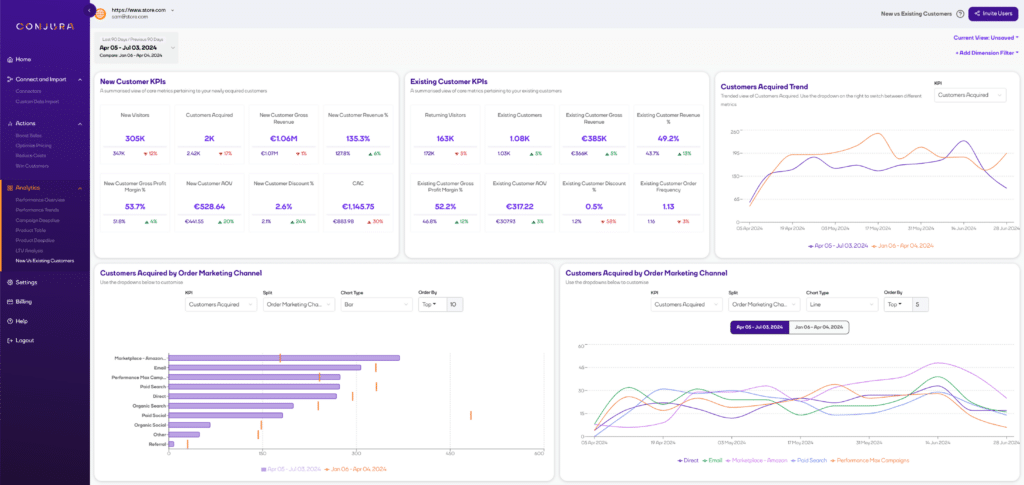If you run an eCommerce brand, you will have seen how the industry has changed over the last few years. What began as a novel way to buy and sell goods online has snowballed into a complex ecosystem where success hinges on not just having a seamless digital storefront but a deep understanding of the individuals behind the transactions, also known as your customers (hence the importance of customer analytics!).
The early days of eCommerce were characterized by a “build it and they will come” mentality. Businesses focused on establishing an online presence and driving traffic, often with limited insight into who their customers were or how they behaved once they arrived.
However, as the market matured and competition intensified (thanks Covid…), it became clear that this approach was unsustainable. The cost of acquiring customers rose, margins tightened, and the need to optimize and understand every touchpoint in the customer journey became vital. This shift has propelled customer data from a mere byproduct of transactions to the lifeblood of a successful eCommerce strategy.
Today, eCommerce businesses are drowning in data – website traffic, purchase histories, product performance, social media interactions, email engagement, and more. The challenge lies not in collecting this data, but in extracting meaningful insights that can be translated into actionable strategies. This is where a platform like Conjura comes in.
Customer analytics is the process of collecting, analyzing, and interpreting customer data to gain a comprehensive understanding of customer behavior, preferences, and needs. It goes beyond simply tracking sales figures; it delves into the “why” behind the “what,” uncovering the motivations and drivers that influence purchase decisions.
In this article, we will explore the important role that customer analytics plays in maximizing eCommerce profitability. We’ll delve into key customer metrics, effective analysis techniques, and practical applications of customer insights, including how to leverage customer segmentation for targeted marketing and personalized experiences.
Identifying Key eCommerce Customer Metrics That Impact Profitability
Before we dive into analysis techniques, it’s worth identifying the key customer metrics that directly impact your bottom line. These metrics help guide your analytics efforts, helping you focus on the areas that really matter.
Customer Acquisition Cost (CAC)
CAC represents the average cost of acquiring a new customer. It encompasses all marketing and sales expenses, including advertising spend, salaries, and commissions, divided by the number of new customers acquired within a specific period. A high CAC indicates that you’re spending too much to acquire each customer, eroding your profitability.
Customer Lifetime Value (LTV)
LTV predicts the total revenue a business can expect from a single customer over their entire relationship with the brand. It takes into account factors such as average purchase value, purchase frequency, and customer retention rate. Increasing LTV is crucial for sustainable growth, as it’s generally more cost-effective to retain existing customers than to acquire new ones.
Churn Rate
Churn rate measures the percentage of customers who stop doing business with your company within a given timeframe. High churn rates can significantly impact profitability, as it means you’re constantly losing customers and having to replace them with new ones. Understanding why customers churn is essential for implementing effective retention strategies.
Average Order Value (AOV)
AOV is the average amount spent by a customer per transaction. Increasing AOV can boost revenue without necessarily increasing the number of transactions. Strategies for increasing AOV include upselling, cross-selling, and offering volume discounts.
Conversion Rate
Conversion rate is the percentage of website visitors who complete a desired action, such as making a purchase. A low conversion rate indicates that you’re not effectively turning website traffic into paying customers. Optimizing the user experience and addressing customer pain points can improve conversion rates.
Retention Rate
The percentage of customers who continue to purchase from your business over a given period. High retention rates directly correlate with increased LTV and profitability.
LTV to CAC Ratio
This ratio compares the Customer Lifetime Value to the Customer Acquisition Cost. It indicates the return on investment for acquiring new customers. A higher ratio generally signifies that your business is efficient in acquiring valuable customers.
By closely monitoring these key metrics, businesses can gain a clear picture of their customer acquisition and retention efforts, identify areas for improvement, and make data-driven decisions to maximize profitability.

Techniques for Analyzing Customer Purchase Patterns and Spending Habits
Once you’ve identified the key metrics, the next step is to delve deeper into customer purchase patterns and spending habits. This involves employing various analysis techniques to uncover valuable insights from your customer data.
RFM Analysis
RFM analysis is a powerful technique for segmenting customers based on their Recency (how recently they made a purchase), Frequency (how often they make purchases), and Monetary value (how much they spend). By scoring customers on each of these dimensions, you can identify your most valuable customers, those at risk of churning, and those with the potential for increased spending.
Cohort Analysis
Cohort analysis involves grouping customers based on a shared characteristic, such as their acquisition date, and then tracking their behavior over time. This technique allows you to identify trends in customer retention, LTV, and other key metrics, and to compare the performance of different customer groups.
Purchase Sequence Analysis
This analysis examines the order in which customers purchase different products or categories. It can reveal valuable insights into customer preferences, buying journeys, and opportunities for cross-selling and upselling.
Basket Analysis
Basket analysis identifies products that are frequently purchased together. This information can be used to optimize product placement, create targeted promotions, and personalize product recommendations.
Customer Journey Mapping
While not strictly an “analysis” technique, customer journey mapping is a crucial process that complements customer analytics. It involves visualizing the complete customer experience across all touchpoints, from initial awareness to post-purchase support. By mapping the customer journey, businesses can identify pain points, opportunities for improvement, and areas where data can be used to personalize interactions.
Executing these analysis techniques without the correct infrastructure can become incredibly messy, inaccurate and time-consuming. By leveraging a tool like Conjura’s ‘Purchase Patterns’ dashboard, your brand can effortlessly compile and visualise all of this data to impact strategic marketing flows, bundles and product suggestions.
Using Data to Optimize Pricing Strategies and Inventory Management
Customer analytics isn’t just about understanding customer behavior; it’s also about using those insights to optimize key business operations, such as pricing and inventory management.
Pricing Strategies:
- Price Sensitivity Analysis: Analyze how changes in price affect customer demand. This can help you determine the optimal price point for different products and customer segments.
- Competitive Pricing Analysis: Monitor competitor pricing to ensure your prices remain competitive while maintaining profitability.
- Dynamic Pricing: Implement dynamic pricing strategies that adjust prices in real-time based on factors such as demand, inventory levels, and competitor pricing – it’s not for everyone, but worth considering!
Inventory Management:
- Demand Forecasting: Use historical sales data and customer behavior patterns to forecast future demand and optimize inventory levels.
- Inventory Turnover Analysis: Track how quickly your inventory is selling. A low turnover rate may indicate overstocking or slow-moving products.
- Stockout Analysis: Analyze the impact of stockouts on sales and customer satisfaction. This can help you prioritize inventory replenishment efforts.
Leveraging customer analytics to support pricing and inventory decisions is a great way to support wider data and strategic decisions – helping maximize revenue, minimize costs, and improve overall efficiency.
How to Leverage Customer Segmentation Data with Conjura’s ‘Customer Table’ for Targeted Marketing and Personalized Experiences
General customer analytics are great…but customer segmentation is where it’s at. As mentioned earlier, customer segmentation involves dividing your customer base into distinct groups based on shared characteristics. These characteristics can include demographics, purchase history, behavior patterns, and more.
The beauty of segmentation lies in its ability to enable highly targeted marketing via a CRM (such as Hubspot or Klaviyo) and to deliver a personalized experience. Instead of sending generic marketing messages to your entire customer base, you can tailor your communications to the specific needs and preferences of each segment.
Here’s how to leverage customer segmentation data with Conjura’s ‘Customer Table’:
1. Define Your Segmentation Criteria
Start by identifying the most relevant criteria for segmenting your customers. With Conjura’s new ‘Customer Table’ feature, you can identify:
- Most profitable customers: Who’s spending the most within a certain time period
- Bargain hunters: Customers who purchase frequently discounted products
- Highest refunding customers: See who is sending products back and why
- Lapsed customers: One time buyers, can you entice them to buy again?
These are just a handful of segments that you can create in Conjura’s ‘Customer Table’.
2. Create Your Segments
Use ‘Product Table’ to create and save segments based on your chosen criteria. The possibilities are endless!
3. Develop Targeted Marketing Campaigns
Export your enriched customer data in a CSV file, upload it to your CRM and Craft marketing messages/offers that resonate with the specific needs and preferences of each customer segment. For example, you might offer discounts on products to bargain hunters or promote high-end items to your most valuable customers.
Wrapping things up, the old saying Knowledge is power rings true. However, at Conjura we strongly believe that eCommerce brands shouldn’t be aimlessly drowning in data – which is pretty easy to do nowadays!
That’s why we’ve developed the Conjura platform to deliver an intuitive user experience that effortlessly presents key data that impacts your business. Sign up for your free trial below.
